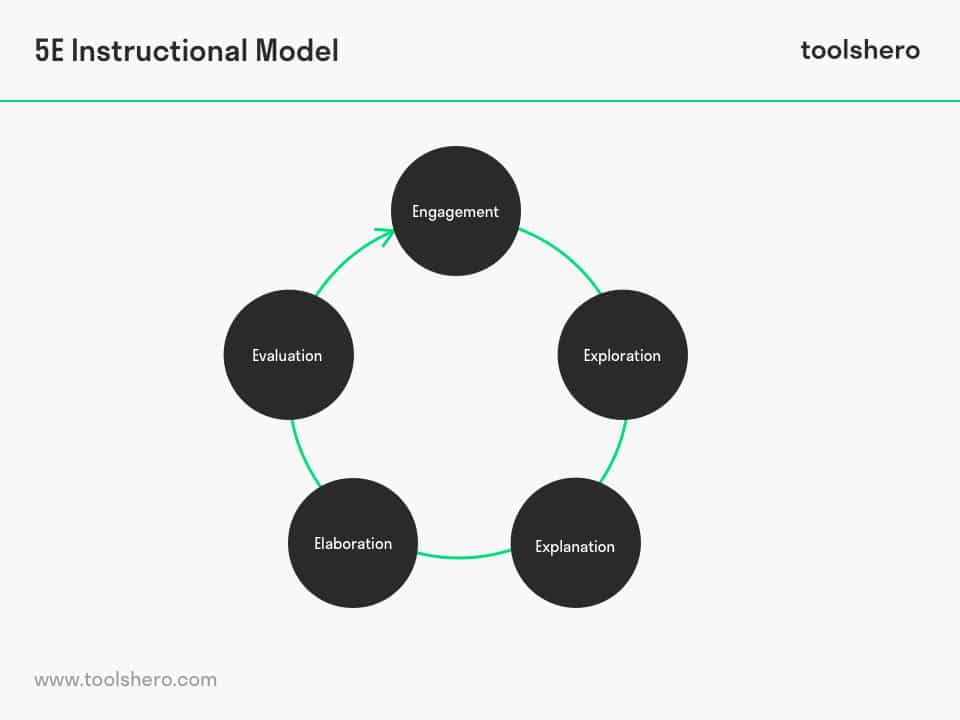5E Instructional Model

5E Instructional Model: this article provides a practical explanation of the 5E Instructional Model, also known as the 5E Learning Cycle. After reading, you’ll understand the basics of this powerful effectiveness tool.
What is the 5E Instructional Model?
Learning is a continuous process, regardless of whether you’re young or old. It keeps people focused and enables them to improve themselves. The 5E Instructional Model can help to facilitate the entire learning process. This model can be applied within education as well as within organisations.
It offers solace wherever people work. The model is used as a framework for ordering and organising lessons. Once implemented, it also helps teachers in class situations to make the best on-the-spot decisions to respond to challenges posed by students.
The teacher in question can also be a trainer, someone who trains a group of employees to improve their abilities, or an instructor who tells a department how to make the best use of newly installed software.
With the 5E Instructional Model, teachers, trainers, and instructors have an instructional model at their disposal which helps their pupils, students, or trainees gain a complete understanding of new concepts. They can more optimally involve their students in the given material and motivate them to learn more.
The model also helps to guide them in developing their skills. The model is characterised by active learning, in which students work together to solve problems and explore new concepts by asking questions, observing, analysing, and drawing conclusions.
History 5E Instructional Model
As early as 1962, American educationalist Myron J. Atkin and American physicist Robert Karplus developed an effective learning cycle that included ‘exploration’, ‘terminology’, and ‘concept application’.
As a result, students became interested in subjects, started asking questions, and discovered that they needed to look critically at their own insights. The Aktin-Karplus model forms the basis of the 5E Instructional Model. This was developed in 1987 by the American education and research institute BSCS Science Learning.
5 phases
The 5E Instructional Model of BSCS Science Learning consists of the following five phases:
1. Engagement
In this first phase of the 5E Instructional Model, the teacher, trainer, or instructor assesses the prior knowledge of the pupil, student, or trainee and tries to identify gaps in that knowledge. In addition, they will take care to pique the student’s interest in the upcoming topic.
Only when there is interest, will the pupil then be involved enough to be open to new information. The teacher, trainer, or instructor can subsequently start asking open questions and encourage the student to write down everything they already know about the subject. All activities should link what pupils already know with what they are about to learn. Their curiosity needs to be piqued.
2. Exploration
It’s after the first phase that the ‘Exploration’ phase comes into play. Pupils are encouraged to take in the new information by means of concrete learning experiences. They are encouraged to make observations, make mistakes, and find out what happens next.
In particular, when they start working together with the new information, they can collaberate to find out what works, what doesn’t work, and what they already know. Their prior knowledge helps to generate new ideas, explore questions and possibilities, and design and implement a preliminary study.
3. Explanation
In the explanation phase, pupils are encouraged to think carefully about the new information and to understand exactly what it is all about. The teacher, trainer, or instructor will guide the pupil, student, or trainee in compiling new knowledge and will provide them with information when they need further clarification.
They will ask their students questions to find out what they have learned so far. In this phase, the teacher, trainer, or instructor will come up with clear explanations and examples and will often work with supporting tools such as PowerPoint presentations, models, videos, or roleplaying to increase their pupils’ understanding of the concept(s).
Their main purpose is to demonstrate conceptual understanding, process skills, or specific behaviour, as well as to introduce the information directly. In this way, the teacher’s explanation gives the student deeper insight.
4. Elaboration
In the elaboration phase of the 5E Instructional Model, the teacher, trainer, or instructor allows the pupil, student, or trainee to directly apply what he or she has learned. This will allow them to develop even more. Pupils apply what they have learned by carrying out a certain activity and performing. This can take the form of an internship assignment, exercise, roleplay, written paper, or test. Through new experiences, pupils develop even more understanding, receive more information, and acquire adequate skills.
5. Evaluation
In the evaluation phase, pupils, students, or trainees are encouraged to assess their own skills and knowledge independently. They ask themselves what they already know and what information is still missing. In addition, it offers teachers, trainers, and instructors the opportunity to evaluate students’ progress. Both formal and informal assessments can be used, in which students are observed and also come to conclusions with each other. By asking themselves what went well and what could be improved, they arrive at self-reflection and are able to improve themselves.
Each phase has a specific function and contributes to a coherent instruction by the teacher, trainer, or instructor. As a result, pupils, students, or trainees are better able to learn and understand scientific and technological knowledge, attitudes, and skills.
The complete learning cycle
The whole purpose of the 5E Instructional Model is to take students to the next level. It helps students to build a strong knowledge base through active participation. The model is based on the fact that people acquire knowledge and give meaning to it through experiences.
The model is most effective when students come into contact with new information for the first time. In that case, there is a chance of a complete learning cycle that starts with the first phase of involvement and ends with evaluation.
The best results can be achieved by allocating about two weeks for each phase. This usually works better than just focusing on one of the phases. Spending too much time on a single phase causes students to quickly forget what they learned before.
Now it’s your turn
What do you think? Do you recognize the explanation about the 5E Instructional Model / 5E learning cycle? Do you use the 5E model in practice or are there other instruction models that you use? Are there any tips or additions you would like to share?
Share your experience and knowledge in the comments box below.
More information
- Bybee, R. W., Taylor, J. A., Gardner, A., Van Scotter, P., Powell, J. C., Westbrook, A., & Landes, N. (2006). The BSCS 5E instructional model: Origins and effectiveness. Colorado Springs, Co: BSCS, 5, 88-98.
- Duran, L. B., & Duran, E. (2004). The 5E Instructional Model: A Learning Cycle Approach for Inquiry-Based Science Teaching. Science Education Review, 3(2), 49-58.
- Wyatt, S., Dopson, N., Keyzerman, Y., & Daugherty, J. (2014). The 5E instructional model. Grounded designs for online and hybrid learning online and hybrid learning designs in action, 2, 51.
How to cite this article:
Mulder, P. (2019). 5E Instructional Model . Retrieved [insert date] from Toolshero: https://www.toolshero.com/personal-development/5e-instructional-model/
Add a link to this page on your website:
<a href=”https://www.toolshero.com/personal-development/5e-instructional-model/”>Toolshero: 5E Instructional Model </a>
Published on: 16/07/2019 | Last update: 22/03/2024







